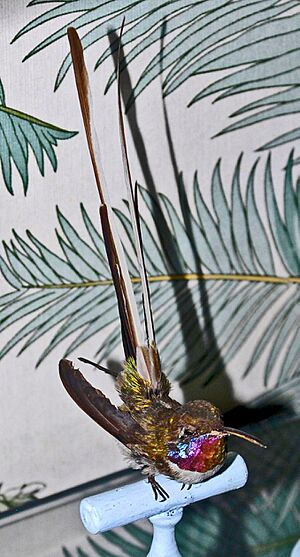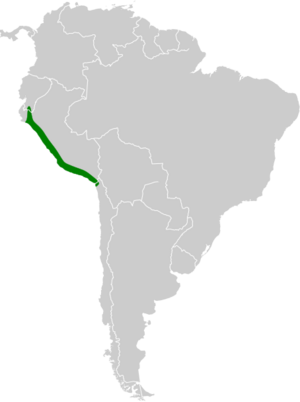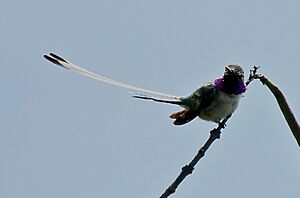Peruvian sheartail facts for kids
Quick facts for kids Peruvian sheartail |
|
|---|---|
 |
|
| Museum specimen | |
| Conservation status | |
| Scientific classification | |
| Genus: |
Thaumastura
|
| Species: |
cora
|
| Synonyms | |
|
Ornismya cora |
|
The Peruvian sheartail (Thaumastura cora) is a tiny and beautiful hummingbird. It's known for the male's incredibly long and unique tail feathers. This bird is the only species in its group, called Thaumastura. You can find the Peruvian sheartail living in parts of Chile, Ecuador, and Peru.
Contents
About the Peruvian Sheartail
The Peruvian sheartail was first described in 1827. For a while, people thought there were different types (subspecies) of this bird. But scientists later realized that these differences were just normal variations among individual birds. So, now we know there's only one kind of Peruvian sheartail, and it's the only member of its genus, Thaumastura.
Even though it's unique, the Peruvian sheartail is related to other small hummingbirds. These include the short-tailed woodstar, the purple-collared woodstar, and the oasis hummingbird.
What Does It Look Like?
The male Peruvian sheartail is about 14 cm (5.5 in) long. That's pretty small! It weighs around 2.5 g (0.088 oz), which is lighter than a penny. The female is even smaller, about 7.5 cm (3.0 in) long, and weighs about 2.6 g (0.092 oz). Both male and female birds have a short, straight, black beak.
Their upper bodies, including the top of their heads, are a shiny metallic green. This green color gets darker towards their tail. Females have a slightly beige tint to their green feathers. Both sexes also have a small, faint white spot right behind their eyes.
Male and Female Differences
The male Peruvian sheartail has a bright, iridescent magenta throat patch, called a gorget. This patch can look blue or even black depending on how the light hits it. The female's throat is a creamy color. The male's chest and belly are off-white to gray, blending softly into the green of his back. The female's chest and belly are similar but a bit darker.
The male's tail is its most amazing feature. The two innermost feathers are short. The next pair of feathers are very long, with black outer edges and white inner edges. The other three pairs of feathers are shorter, also with black outer edges and white inner edges.
The female's tail is short and doesn't have the dramatic long feathers of the male. Her tail feathers are mostly black with white tips.
Some scientists believe the Peruvian sheartail might be the lightest hummingbird in South America. Other tiny hummingbirds that are also very light include the short-tailed woodstar and some other woodstar species.
Where Does It Live?
The Peruvian sheartail lives in the dry coastal areas of southwestern Ecuador, all along western Peru, and into northwestern Chile. It has only recently been seen in Ecuador, with the first sightings in the early 2000s. It is also expanding its territory in Chile, where it was first reported in 1971. For example, in the Azapa Valley in Chile, there are now thousands of these birds.
These hummingbirds prefer dry coastal areas with scattered, scrubby plants. However, they are also happy living in places changed by humans, like farms, gardens, and fruit orchards. You can find them from sea level up to about 2,800 m (9,200 ft) high. They might even go higher, but they are most common closer to the coast.
Behavior and Habits
Movement
Peruvian sheartails usually stay in the same area for most of their lives. But because they have started living in new places, like isolated patches of green land in dry areas, they must sometimes fly to explore new territories.
Feeding Habits
The Peruvian sheartail drinks nectar from many different kinds of flowers. This includes both native plants and introduced ones, like Eucalyptus trees. They usually hover in front of flowers to feed, but sometimes they will cling to the flower instead. They also visit hummingbird feeders that people put out.
During the breeding season, male Peruvian sheartails protect their own areas. It's not always clear if they are guarding food sources or places to attract a mate. Besides nectar, they also catch small insects. They do this by flying out from a perch to snatch insects in the air, a behavior called hawking.
Reproduction and Life Cycle
Male Peruvian sheartails defend their territories during the breeding season. Some of these territories have lots of flowers, while others have very few. This makes it hard to know if they are protecting food or just a spot for courtship displays. Females usually stay hidden deep in the plants. Males perform special display flights, sometimes even flying into the dense cover where females are.
These display flights can be long, J-shaped "dives" where the male flies down and then up. Or they can be "shuttles," which are shorter, more horizontal flights. During most dives and some shuttles, the male spreads his tail feathers. This creates a fluttering sound. Males also sing during their shuttle flights, but not during dives.
Scientists don't know much about the Peruvian sheartail's breeding habits. However, there is some evidence that they might breed twice a year. This happens between March and May, and again between September and November. Their nest is a small cup shape. Some nests have even been seen decorated with tiny flowers on the outside, instead of the lichen that many other hummingbirds use. The time it takes for the eggs to hatch and for the young birds to leave the nest is not yet known.
Vocalization
The male Peruvian sheartail's song is described as "squeaky" and "incessant." It has at least four different sounds. The male sings from a perch or during his shuttle flights, and his song can last for a minute or more. He also makes shorter versions of his song when he has conflicts with other males. Both male and female Peruvian sheartails make a short "chip" call.
Conservation Status
The IUCN (International Union for Conservation of Nature) has listed the Peruvian sheartail as a species of "Least Concern." This means that it is not currently considered to be in danger of extinction. It lives across a fairly large area, and even though we don't know the exact number of birds, their population is thought to be stable. The Peruvian sheartail is good at living in areas changed by humans, like gardens, so it is not threatened by changes in land use.





